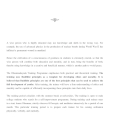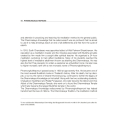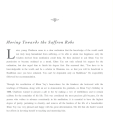knowledge in Buddhism : ค้นหาหนังสือธรรมะ หน้า 4 / 5
หน้าหนังสือทั้งหมด

74
The Power of Generosity and the Languages of Buddhism
The practice of generosity is the easiest one to perform, and the fruits of merit are the
quickest to materialize. The merit result from the practice of generosity is riches and
wealth to the one wh
The practice of generosity is vital in Buddhism, revealing that giving attracts wealth while selfishness repels it, backed by the Law of Karma. Pali and Sanskrit are essential Buddhist languages, with

4
Mahāyāna Buddhism: Reasons for Diversity in the Buddha’s Teachings
Here is the extracted text from the image:
---
178
ธรรมาธวก วัตรวรรณวรวิทยาการทางพระพุทธศาสนา
ปีที่ 6 ฉบับที่ 2 (ฉบับสมบูรณ์ที่ 11) ปี 2563
**Mahāyāna Buddhism: Reasons for Diversity in the Budd
เอกสารนี้กล่าวถึงการอยู่ร่วมกันของโรงเรียนพุทธในสมัยพระเจ้าอชาตศัตรู และการยอมรับความหลากหลายของหลักธรรมที่เกิดขึ้น ทำให้เกิดมหายานที่อ้างว่า การเข้าถึงพุทธคติสามารถทำได้โดยทุกคนไม่ว่าจะเป็นพระหรือฆรา

6
วิวัฒนาการของอันตรภาคในพระพุทธศาสนา
ธรรมภาษ วรรณวิชาการทางพระพุทธศาสนา
ปีที่ 7 ฉบับที่ 2 (ฉบับรวมเล่มที่ 13) ปี 2564
บทนำ
พระพุทธศาสนาปฏิรูปสงฆ์ของ “atman” (อาตมัน) หรือ
“atta” (อัตตา) ซึ่งศาสนาพราหมณ์-ฮินดูถือว่าเป็นสิ่งที่เที่ยงแท้
บทความนี้พูดถึงการปฏิรูปของพระพุทธศาสนาเกี่ยวกับคำว่า “atman” และ “atta” ที่เกี่ยวข้องกับกรรมและการเกิดใหม่ พร้อมวิเคราะห์ความหมายของอันตรภาคระหว่างมรณภาพและการเกิดใหม่ ตามความเชื่อในพระพุทธศาสนา โดยอ

20
Superior Love through Superior Dhamma
Superior Love
through Superior Dhamma
Because we are human beings, none of us are perfect.
We all come with a baggage of deficiencies. We can
cope with our own deficiencies but we cannot
tolerate some
This text discusses the challenges of living with a partner and how the Dhamma provides guidance for a harmonious family life. It highlights the four virtues: truthfulness, self-control, endurance, an

19
The Importance of Sacrifice in Marriage
own personal desires, and the husband and wife do not combine
their incomes from the beginning, that means that one is
preparing go one's separate way from the start because neither
person is thinking
Marriage requires mutual dependence and sacrifice between partners. Couples should consider their ability to support each other emotionally and financially, especially during illness or hardship. Self

11
The Quest for Knowledge and Happiness
Preface
Why, since the existence of mankind, have we
unceasingly put all of our resources in order to search for
newer knowledge and technology? Taking this question back
to its roots, we will eventua
This preface discusses the fundamental reasons behind humanity's relentless pursuit of knowledge and technology. It highlights how ignorance leads to suffering and fear, emphasizing the need for knowl

184
Journey to Joy
Journey to Joy
all secrets and leave us without doubts. We will
possess the right knowledge about the purpose of
life and consequently follow a correct path - one
that is more fruitful and substantive
Journey to Joy explores the transformative power of the Dhammakaya, emphasizing how true knowledge within ourselves can create happiness and purpose. By unlocking this wisdom through meditation, we ca

80
Cultivating Goodness in Education
A wise person who is highly educated may use knowledge and skills in the wrong way. For example, the use of advanced physics in the production of nuclear bombs during World War II has inflicted a perm
This text emphasizes the importance of combining education with morality to promote the wise use of knowledge. It highlights the Dhammadayada Training Programme, which uses Buddhist principles to inst

54
Raising Smart and Virtuous Children
utilize the four requisites, how they work, and how they
conduct their daily activities.
Parents can instill wholesomeness, intelligence, and
compassion towards others by teaching their children resp
This text discusses the importance of teaching children the four requisites—respect, discipline, and endurance. It emphasizes the balance between worldly wisdom and Dhamma wisdom, highlighting how bot

48
Phramongkolthepmuni: A Legacy of Dhammakaya Meditation
44 PHRAMONGKOLTHEPMUNI
and attention in practicing and teaching his meditation method to the general public.
The Dhammakaya Knowledge that he rediscovered was so profound that he aimed
to use it to h
Phramongkolthepmuni, originally Sodh Chandasaro, became abbot of Wat Paknam Bhasicharoen in 1918. Known for his meditation mastery, he organized workshops leading many to attain the Dhammakaya level.

17
Understanding True Education and the Role of Kilesa
to refrain from involvement with bad company by keeping the company of true friends and fulfilling other's duty towards each other.
TRUE EDUCATION
Education is, in fact, to explore ourselves and find
การศึกษาที่แท้จริงคือการสำรวจตัวเองและเข้าใจข้อบกพร่องของเรา การศึกษาเพื่อแก้ไขการกระทำที่ไม่ดีและสร้างกรรมดีช่วยให้ลดทุกข์ในชีวิตได้ โดยมีการจัดการที่เหมาะสมเพื่อยกระดับศีลธรรมและความรับผิดชอบในสังคม

26
The Importance of Good Habits in Education
CHAPTER 2
Furthermore, a good education system is essential in assisting the parent to
continue to build the knowledge of the individual along the right path to further
strengthen the fabric of human
This chapter discusses the significance of a solid education system in fostering good habits among individuals which leads to mental, physical health, and societal benefits. It defines habits, categor

45
The Importance of Moral Education in Teaching
Only with moral education can human beings eliminate conflicts, selfish and greedy tendencies and practices so that man may truly coexist with mindful and peaceful consideration for each other. This s
This text emphasizes the necessity of moral education to eliminate selfish and greedy tendencies, enabling peaceful coexistence. It discusses the role of various types of teachers—parents, school teac

4
The Warm Hearted Family
The presence of the newborn will force the parents to work
even harder, so they will have enough to care for the child. The
more children they decide to have; the more their responsibilities
will incr
หนังสือเล่มนี้นำเสนอความรู้และประสบการณ์ในการฝึกอบรมตนเองเพื่อลดกิเลสและสร้างครอบครัวที่อบอุ่นและรักใคร่ การเลี้ยงดูเด็กอย่างเหมาะสมจะช่วยให้เด็กเติบโตเป็นคนดี หากเลี้ยงดูไม่ถูกต้องจะทำให้พวกเขามีพฤติ

61
Understanding Dhammakaya Knowledge
The Dhammakaya Knowledge is taught by the Buddha to constitute the transcendental, blissful, eternal, and pure Self of the Buddha. Dhammakaya doctrines can be found in the scriptures of all major Budd
Dhammakaya Knowledge is a profound teaching from the Buddha that emphasizes the transcendental, blissful, and pure nature of self. This concept is integral to all major Buddhist schools, including The

20
The Journey of Chaiyaboon and the Establishment of Dhammakaya Temple
Here is the extracted text from the image:
---
Chaiyaboon achieved a high level of success in the Dhammakaya meditation practice, and Khun Yai assigned him to teach meditation to others.
Chaiyaboon
Chaiyaboon, a successful practitioner of Dhammakaya meditation, pursued his true calling as a Buddhist monk after graduating from Kasetsart University in 1969. Known as Luang Por Dhammayenyo, he becam

42
Moving Towards the Saffron Robe
Moving Towards the Saffron Robe
Later, young Chaiboon came to a clear realisation that the knowledge of the world could not truly keep humankind from suffering, or be able to attain true happiness; o
In this narrative, young Chaiboon realizes that worldly knowledge cannot prevent suffering or grant true happiness; only meditation can. He seeks Khun Yay’s permission to become a monk, but she advise

20
Exploring the Cakras and Early Buddhism
the cakras are located, a location that suggests comparisons with Tantra.
While the primary focus of this journal is dhammakāya, Luang Phaw Dhammajayo has instructed the Director of DIRI, Phrakrupladn
This journal focuses on the study of cakras and early Buddhism, emphasizing neutrality across Buddhist schools. Under the direction of Luang Phaw Dhammajayo, the Director of DIRI, Phrakrupladnayokwara

166
Understanding the Tipitaka and Buddhist Concepts
Tipitaka (Skt, Tripitaka): Buddhist scripture. Tipitaka means the Three Baskets. They consist of the Basket of Discipline (Vinaya Pitaka) – rules and regulations of the Order of monks and nuns; the Ba
Tipitaka, or Tripitaka, consists of three main sections: Vinaya Pitaka, Sutta Pitaka, and Abhidhamma Pitaka, covering monks' rules, discourses on various human concerns, and psychological aspects of B

14
The Dhammakaya Tradition
The Dhammakaya Tradition
Founded by the Great Abbot of Wat Paknam Bhasicharoen, Phra Mongkhonpuraimi (background picture), the Dhammakaya Knowledge was passed on to Khun Yai Chan Khonnokyoong (center
…d by the Great Abbot of Wat Paknam Bhasicharoen, Phra Mongkhonpuraimi, emphasizes the importance of knowledge in Buddhism. This tradition was further propagated by Khun Yai Chan Khonnokyoong to notable figures like Luang …
